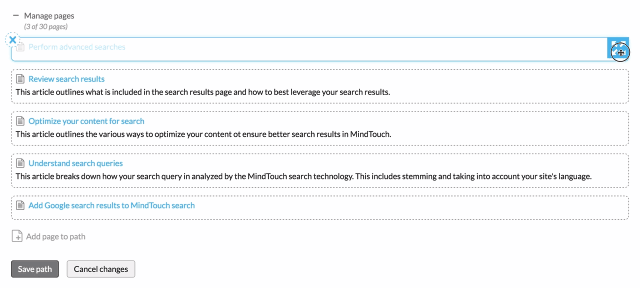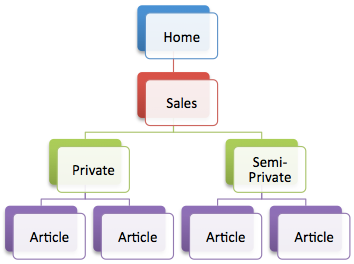Structuring for various departments
- Applies to:
- All versions
- Role required:
- N/A
Why do I want to structure my content for specific departments?
Project stakeholders throughout your company use knowledge in different ways. Some departments produce more knowledge and others consume more. Some departments use small snippets of knowledge while others use rich, in-depth user guides. Understanding how to effectively embrace these different use cases can drive adoption of your Expert project and create significant value for your organization. Benefits include:
- Enable sales reps and sales engineers
- Capture tribal knowledge
- Drive focus and measurable knowledge traffic
- Increase KCS alignment
The standard site structure
Out of the box, Expert provides its default architecture framework. The CXone Mpower Expert framework makes it easy to create effective content structures that are both navigable and searchable. The framework enhances the search experience by offering users a decision tree to facet search results.
A standard Expert structure typically looks as follows:
- Category (Home)
- Category
- Guide
- Article
Most Expert customers use the default architecture structure for product content such as documentation, user manuals, installation guides, etc. However, other use cases may require a different approach, as outlined below.
How do I structure content for different departments?
The following four examples provide models of how to use the same architecture templates for different structures to more effectively engage different users throughout your organization.
| Department | Description | Structure |
|---|---|---|
|
Product |
Your product team is one of the most valuable and consistent resources to provide value to your customers. Your product team typically has technical documentation including:
In additional to a rich source of material, the product team also has a wealth of knowledge among subject matter experts, developers, testers and more. This structure follows the CXone Mpower Expert framework. |
 |
|
Support |
Your support department typically is the front-line for emerging and urgent issues. As agents encounter new issues and identify solutions, they discover a wealth of knowledge that is crucial to capture and centralize. This content may include:
Structure: Set up a private guide and a public guide to accommodate both agent-only and customer-facing material. Configure your customer engagement software to enable agents to publish basic content (problem, solution) to your site. |
 |
|
Training |
Training and eLearning departments typically generate an abundance of rich content that is primed to drive adoption and create experts. Exposing this content on your site makes sure that your training is available by automatically relating to your product and support articles. Training content typically includes:
Structure: Set up a guide for each source of training material. Make sure you tag your training material to ensure strong article relationships throughout your product and support content. |
 |
|
Sales |
Sales is perhaps the highest value beneficiaries of your content. If you have successfully populated your Expert site with product, support and training material, you can be sure that your sales team can put it to good use. In additional to leveraging the content, your sales engineering are great contributors and can create reusable content that helps close deals. It is crucial to get your sales engineers contributing content such as:
Structure: Set up private and semi-private guides to accommodate your sales-only and prospect content respectively. |
 |
How should I introduce CXone Mpower Expert to my organization?
It is important to engage different stakeholders at the right time. Each department is going to have unique requirements for adoption. For instance, your sales team requires a critical mass of valuable content whereas your product team is more likely to embrace a blank canvas. By using the following maturation plan, you can make sure that each stakeholder is able to receive value from your Expert deployment:






